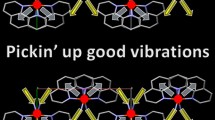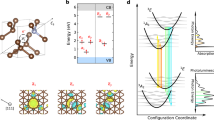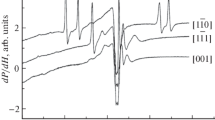Abstract
A simple model is proposed for the spin-dependent infrared absorption band observed in antiferromagnetic NiO crystals. The transition is attributed to the coupled action of the radiation field with the lattice vibrations. The variation of the exchange parameter due to the electric field and the displacement of the ions is taken as the perturbation giving rise to the electric dipole transition between different spin states accompanying the change in the vibrational states. The molecular field approximation is adopted to describe the spin states. The general features of the spectral pattern and its temperature dependence thus obtained are in good agreement with the experiments byNewman andChrenko.
Résumé
Un modèle simple est proposé pour l’absorption infra-rouge dépendant du spin trouvée dans les cristaux anti-ferromagnétiques de NiO. La transition est attribuée à l’action conjuguée de la radiation et des vibrations du réseau. La variation de l’interaction d’échange causée par le champ électrique et le déplacement des ions est considéré comme la perturbation responsable de la transition dipôlaire électrique entre les états différents de spin total et les états de vibration. Afin de décrire le système des spins, on adopte le modèle du champ moléculaire. L’allure générale du spectre prévu théoriquement et sa dépendance avec la température sont en accord avec les résultats expérimentaux deNewman etChrenko.
Zusammenfassung
Das spin-abhängige Infrarot-Absorptionsband in antiferromagnetischen NiO-Einkristallen wird auf Grund eines einfachen Modells untersucht. Die Übergänge werden durch den kombinierten Einfluß von Strahlungsfeld und Gitterschwingungen verursacht. Die Modulation der Austauschwechselwirkung durch das elektrische Feld und die Bewegung der Ionen sind die Störungen, welche die elektrischen Dipolübergänge zwischen den verschiedenen Spin- und Phononzuständen ergeben. Die Spinzustände werden mit Hilfe eines Molekularfeldes beschrieben. Das Spektrum und dessen Temperaturabhängigkeit, die sich aus unserem Modell ergeben, stimmen mit den Meßresultaten vonNewman undChrenko gut überein.
Similar content being viewed by others
References
Koide, S., andY. Mizuno: Helv. Phys. Acta36, 530 (1963).
Newman, R., andR. M. Chrenko: Phys. Rev.114, 1507 (1959).
Sugano, S., andY. Tanabe: Optical Spectra in Magnetically Ordered Materials. Article to be published in Treatise on Magnetism (Academic Press).
Lax, M., andM. Burstein: Phys. Rev.97, 39 (1955).
Born, M., andM. Bradburn: Proc. Roy. Soc. (London) A188, 161 (1946).
Author information
Authors and Affiliations
Additional information
Part I of the present series has been published under the title “Effects of Vibrations on the Crystal Field Line Spectra” in [1].
Rights and permissions
About this article
Cite this article
Mizuno, Y., Koide, S. Vibrationally induced electronic transitions in crystals of magnetic compounds. Phys kondens Materie 2, 166–179 (1964). https://doi.org/10.1007/BF02422874
Received:
Issue Date:
DOI: https://doi.org/10.1007/BF02422874




